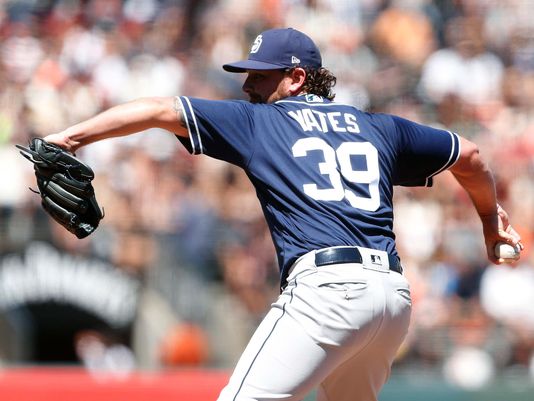With eight days to go until the trade deadline, the series between the Mets and the Padres, two last place teams, may be more notable for its #HugWatch than any of the actual baseball played on the field. Barring the greatest second half comebacks in baseball history, these two teams will be watching October baseball from the couch. What happens over the next eight days, though, might help them reach Octobers to come. Because of the impending deadline, this stat preview focuses on several players the Padres could move before next Tuesday (that is, if they have not already been traded between this writing and the Mets series). Note: All stats and player teams are from before play on Sunday.
Cross Country Kirby: After dealing two valuable late-inning relievers to Cleveland on Thursday, San Diego still has a few good relievers left to dangle in trades. One of those is Kirby Yates, who has seemed to have unlocked his potential after four seasons of average to well below average production. He is ninth in FIP (2.04) and DRA (1.98) and fifth in ERA (1.43) among pitchers with 35+ innings thrown this season. In other words, he has been one of the ten best relievers in baseball without any red flags to suggest his production is about to heavily regress. What has been different for Yates compared to previous years is the usage of a splitter. After adding it to his repertoire last season, Yates has thrown the pitch 35% of the time this year, completely ditching his other changeup and greatly reducing his slider usage. This two-pitch mix has been greatly effective, as the splitter has generated a 26.6% whiff rate and 61.8% ground ball rate. Yates’ overall groundball rate has spiked accordingly, sitting at 50% compared to a previous career high of 43.6%. With three years of team control remaining after 2018, Yates’ name is sure to be heavily discussed in potential trade deals.
Stammen’s Surge: Unlike Yates’ success, which can be pointed towards his splitter, fellow reliever Craig Stammen’s improvement cannot be easily attributed to one area. Instead, Stammen seems to have gotten better a little bit at almost each aspect of his game. He has added a little velocity back compared to last year (up about .5 mph on his sinker), tightened his control (1.75 BB/9 in 2018 compared to 3.14 in 2017), shifted his repertoire slightly to throw his more effective sinker at a greater rate (51.2% in 2017 to 63.6% in 2018) and limited home runs (pitching in Petco probably helps). All of that has seen his FIP (1.92) and DRA (2.99) dip to levels he has not seen since a short stint in 2011. At 34, and with just one more year remaining on his contract, Stammen likely will not command the return Yates will or Brad Hand and Adam Cimber did, but he could still improve most contenders’ bullpens down the stretch.
Hedging their Bets: Since the Padres acquired top catching prospect Francisco Mejia as the return for Hand and Cimber, buzz has been generated that fellow catcher Austin Hedges could be dealt away. Even though Hedges has endured a miserable season at the plate (.233/.288/.372, .224 TAv, 33.8% K%), looking no farther than his defensive skills provides indication of why teams may still value him. Last year, he was the second best pitch framer by Framing Runs (+28), and that, combined with some power production at the plate (18 home runs), made him worth 4.3 WARP. That production would be highly valuable on any team, and may be enough for some teams to overlook his less impressive (but still ninth best) 5.3 Framing Runs and diminished power this season.
Quick Hits
The Good: Robbie Erlin has walked less than a batter per inning over 56 frames this year.
The Bad: San Diego hitters have the most strikeouts as a team with 944. The Mets have 829 (15th).
The Ugly: The Padres have baseball’s lowest slugging percentage and OPS at .367 and .665, respectively. The Mets are fourth-worst at .378 and sixth-worst at .686.
Mets Check-In
You may have already heard, but Noah Syndergaard’s velocity was significantly down last start, almost two mph down on his fastball. He has had two other dips of two mph or more on his fastball from one start to the next (both in 2015), and those were both also on seven or more days of rest, so take from that what you will. Of note, when he returned from the DL last year, his average fastball velo was down about a half mph from where he sat pre-injury, but quickly shot back up above that level in his second start back. Not much research has been done into how hand, mouth and foot disease affects velocity.
Photo credit: Kiel Maddox – USA Today Sports
